The 4080 Super is the latest graphics card to be released in the Nvidia RTX 4000 Super series. The 4080 Super slightly outperforms its immediate predecessor, while released with an MSRP of $200 less than the RTX 4080. Here, we look at how the RTX 4080 Super stacks up using our Peddie mark calculation.
What do we think? Overall, the 4000 Super-series cards are passable, all three versions of the series—the 4070 Super, 4070 Ti Super, and RTX 4080 Super—provide a modicum of performance improvements for the same MSRP: in the case of the RTX 4080 Super, an MSRP of 17% less. The Super versions also score better on the Pmark, providing the consumer more value for their dollar. This is only the case if you can find the graphics cards at MSRP. As of this writing, it has been one day since the launch of the RTX 4080 Super, and we are witnessing prices jumping by as much as $300, while sites such as Newegg have already sold out, with the AIBs on back order. If you are still gaming or creating with an older add-in board such as an RTX 1080 or RTX 2000-series card, then the Super will prove a solid upgrade at more value than the original RTX 4000-series graphics cards.
Putting the “superness” of the RTX 4080 Super to the test
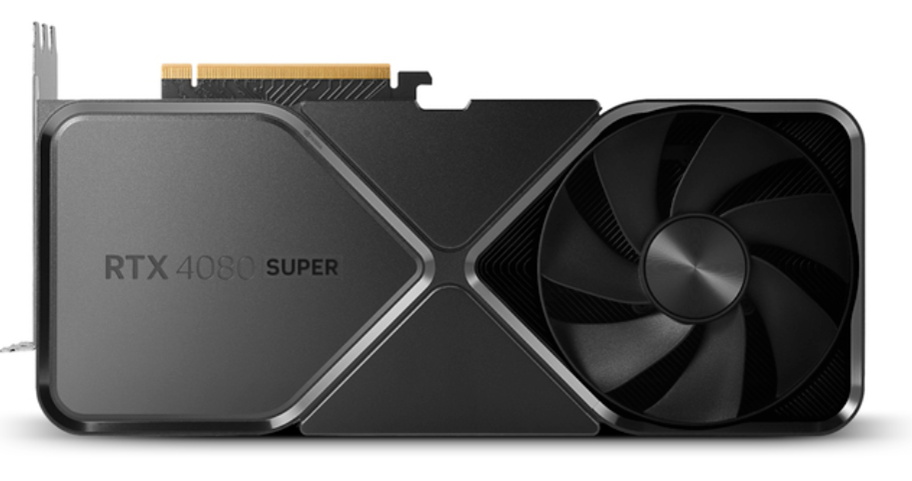
We compared the RTX 4080 Super to its Super-series siblings, along with the original RTX 4000-series cards, the RTX 3080 and AMD’s RX 7800 XT. Our sister site BabelTechReviews posted a thorough review of the new Lovelace-based RTX 4080 Super, which can be read here. In this JPR article, we will be comparing the add-in boards using our JPR calculation (Pmark).
The RTX 4080 Super checks in with 5% more CUDA cores than the RTX 4080 and 5% more ray-tracing cores and TMUs. Nvidia did not increase the onboard memory, with both cards having 16MB of GDDR6X.
The RTX 4080 add-in boards are based on Nvidia’s AD104 GPU. The chart below shows how the two boards stack up against each other.
| RTX 4080 Super | RTX 4080 | Percentage Change | |
| GPU | AD103 | AD103 | NA |
| CUDA Cores | 10,240 | 9,728 | 5% |
| RT Cores | 80 | 76 | 5% |
| TMU | 320 | 304 | 5% |
| Base Clock (MHz) | 2,295 | 2,205 | 4% |
| Boost Clock (MHz) | 2,550 | 2,505 | 2% |
| Memory (GB) | 16 | 16 | 0% |
| Memory Type | GDDR6X | GDDR6X | NA |
| Memory Bus | 256 | 256 | 0% |
| FP32 (TFLOPS) | 52.22 | 48.74 | 7% |
| Bandwidth | 736.3 | 716.8 | 3% |
| TDP | 320 | 320 | 0% |
| MSRP at Launch | $999 | $1,199 | -17% |
| Current Online Price | $1,255 | $1,249 | 0% |
Graphics card comparison of the RTX 4080 Super versus the RTX 4080.
Key Features of the RTX Super series:
- New streaming multiprocessors: Enhanced performance and power efficiency, delivering up to 2× improvements.
- 4th-generation Tensor cores and optical flow: Power AI technologies like Nvidia DLSS 3 for improved frame rates.
- 3rd-generation RT cores: Offer up to 2× ray-tracing performance, creating highly detailed virtual environments.
- Ada memory subsystem: Increased L2 cache for better performance, reduced memory traffic, and power efficiency.
- Shader Execution Reordering (SER): Doubles the efficiency of ray-tracing operations.
- DLSS 3.5: AI-driven graphics enhancement for higher performance and ray-tracing quality.
- Nvidia Studio: Optimal performance for 3D rendering, video editing, and live streaming.
- AV1 encoder: 8th-generation encoder providing 40% more efficiency than H.264, benefiting streamers, broadcasters, and video callers.
Test bed
We benchmark using Nvidia FrameView on a recent install of Windows 11 Pro Edition 22H2 at 3440×1440, using an Intel Core i7-12700K with stock clocks and 32GB of DDR4 Corsair Vengeance RGB Pro (3,600 MHz) memory on an Asus Prime Z690-P D4 motherboard. All games and benchmarks are the latest versions, and we used the latest press drivers for our testing. The games tested, display driver, settings, and hardware are identical except for the GPUs that we compared.
Our benchmark suite consisted of multiple games with 14 different settings running DX11, DX12, and Vulkan, as well as 3DMark synthetic tests. All games were run at 3440×1440 and 4K.
| A Plague Tale: Requiem | Alan Wake 2 |
| Chernobylite w/ RT | Chernobylite Ultra + RT + DLSS |
| Cyberpunk 2077 + DLSS 3 Quality + RT | Cyberpunk 2077 Ultra |
| F1 23 | Resident Evil 4 Ultra |
| Resident Evil 4 w/ RT | Shadow of the Tomb Raider |
BabelTechReviews’ benchmark suite.
Performance
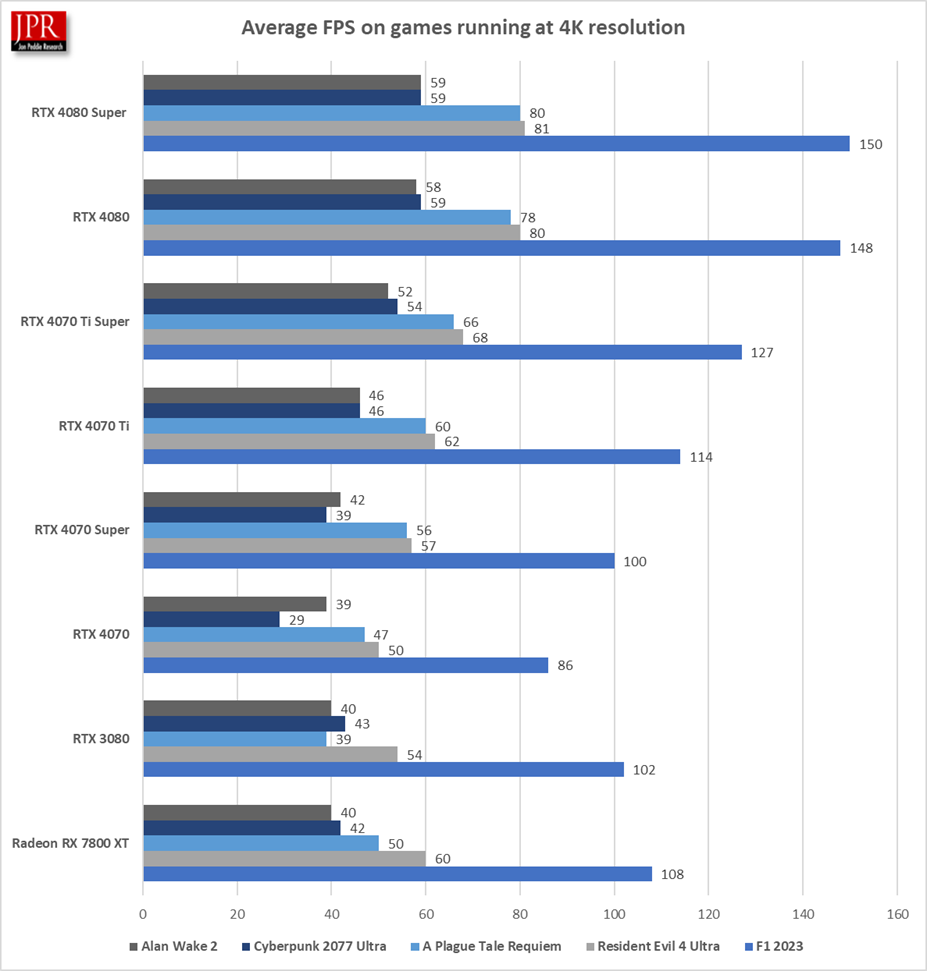
The new RTX 4080 Super shows a modest 2% improvement over the RTX 4080, which might explain the introductory $999 price point, which is $200 less than the RTX 4080’s initial MSRP. The RTX 4080 Super has an impressive 50% performance bump over the previous generation’s RTX 3080.
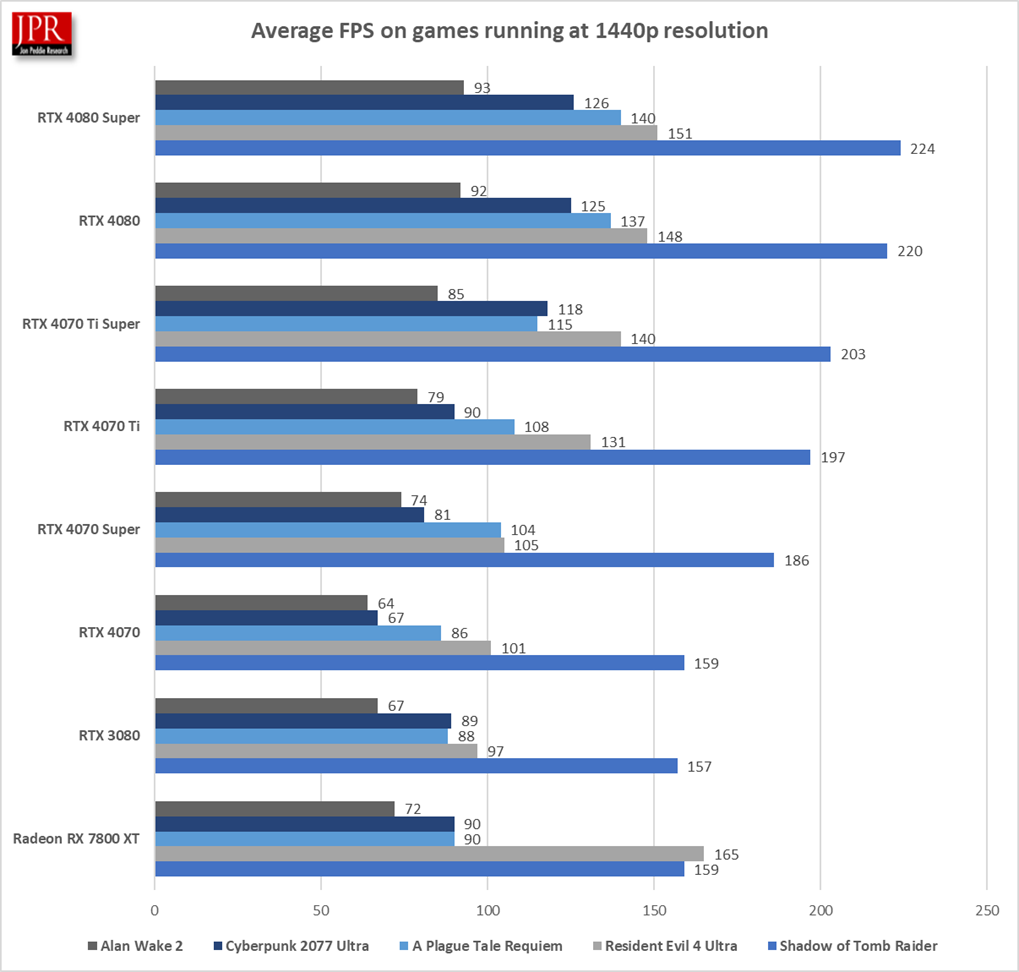
The change in resolution does not change the results we see for the RTX 4080 Super, which shows a 2% improvement over the RTX 4080 and a 40%-plus improvement over the Ampere-based RTX 3080.
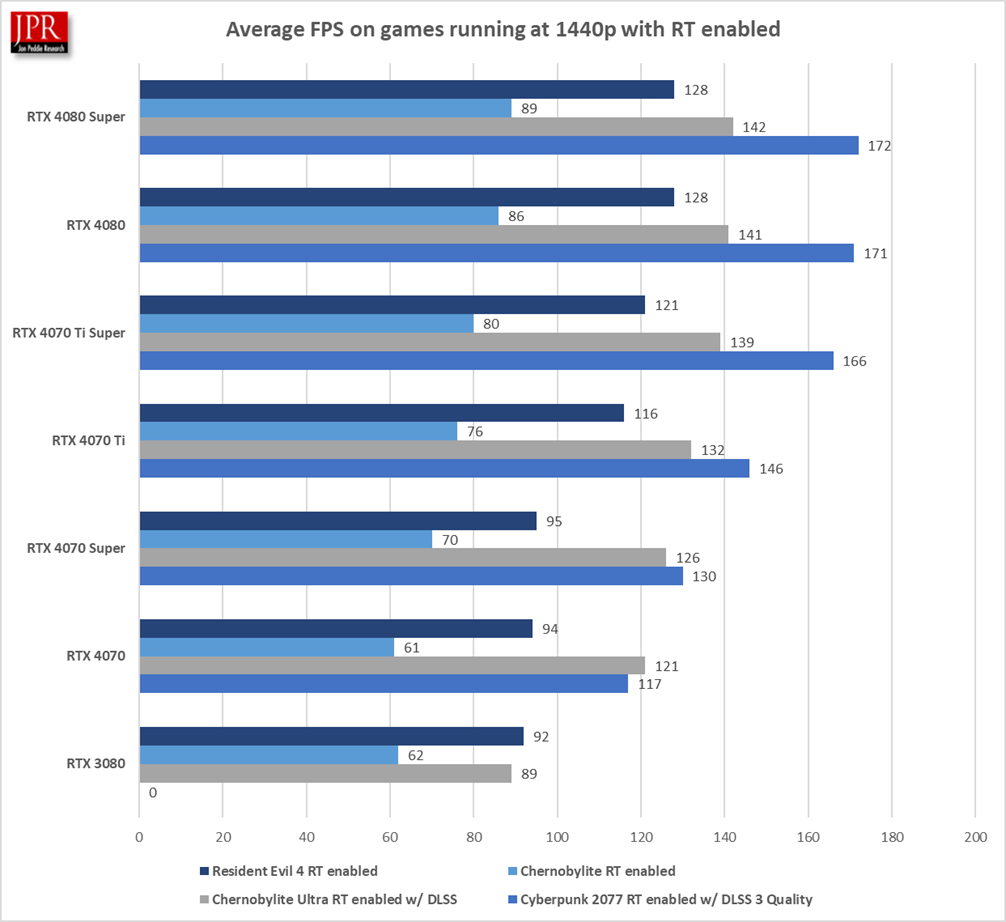
In games running with ray tracing enabled, RTX 4080 Super shows impressive frame rates, with a 2% improvement over the RTX 4080 and a 50%-plus advantage over the RTX 3080.
Pmark calculations
JPR has been using its Pmark calculations to compare graphics boards for over a decade. The Pmark scores factor overall performance of the add-in board as well as its price and power.

| Radeon RX 7800 XT | RTX 3080 | RTX 4070 | RTX 4070 Super | RTX 4070 Ti | RTX 4070 Ti Super | RTX 4080 | RTX 4080 Super | |
| FPS 1440p | 115 | 100 | 95 | 110 | 121 | 132 | 144 | 147 |
| FPS 4K | 60 | 56 | 50 | 59 | 66 | 73 | 119 | 121 |
| FPS 1440p RT enabled | NA | 77 | 76 | 83 | 96 | 101 | 107 | 109 |
| TDP (W) | 263 | 320 | 200 | 220 | 285 | 285 | 320 | 320 |
| MSRP (at launch) | $499 | $699 | $599 | $599 | $799 | $799 | $1,199 | $999 |
Pmark variables.
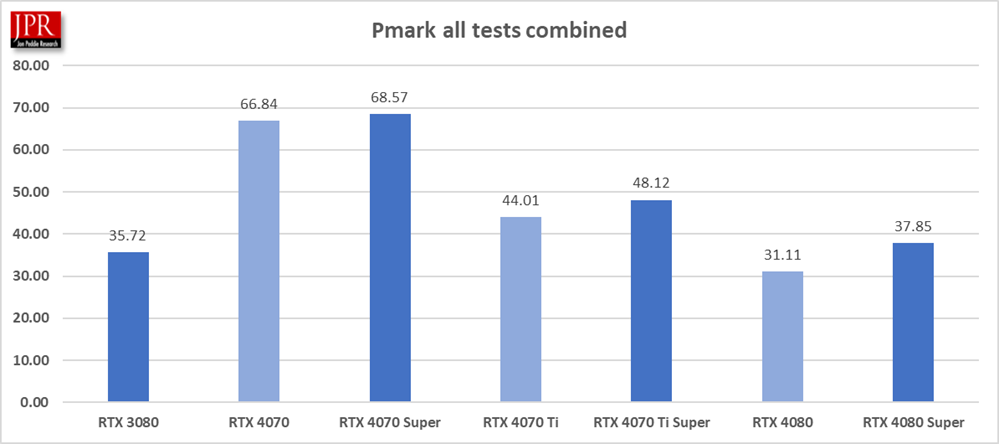
The RTX 4080 Super shined in the Pmark calculation, scoring 22% above the RTX 4080 due to its slightly better performance and lower initial price point. The RTX 4070 Super scored well on the Peddie mark calculation as well, given its solid performance at a low price when compared to its more expensive siblings. All Super-series graphic cards scored better than their 4000 series counterparts.
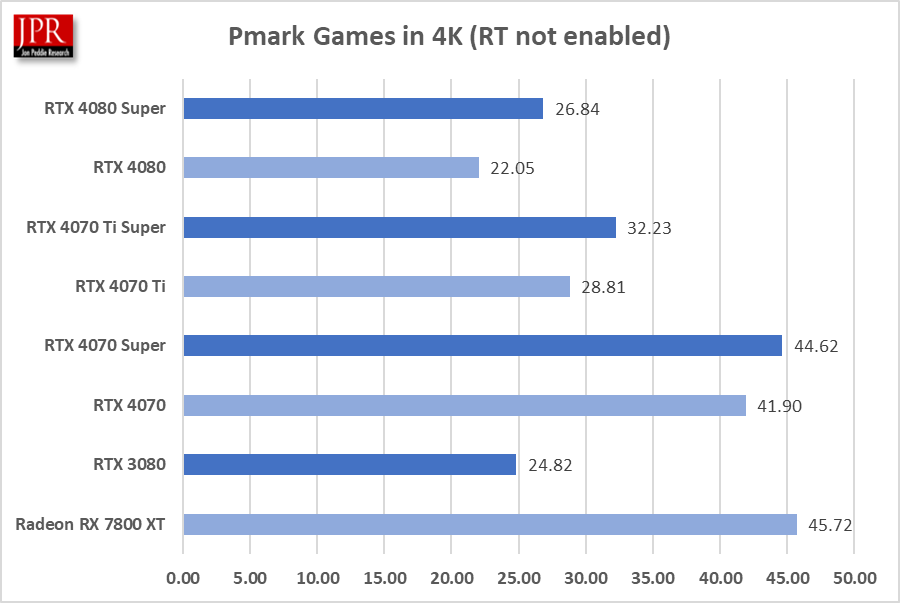
Again, the RTX 4080 Super shows a 20% advantage over the RTX 4080 in the Pmark on games running with 4K resolution. All Super-series cards bested the original 4000-series add-in boards. The RX 7800 XT scored well due to its frame rates in games without RT and its lower price point.
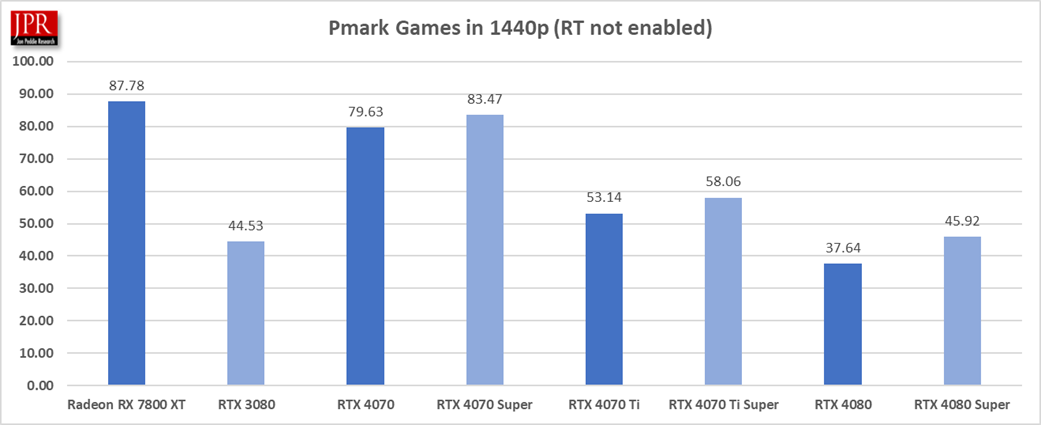
The new Super series again scores well in the 1440p Pmark, scoring with the RTX 4080 Super leading the RTX 4080 by 20%.
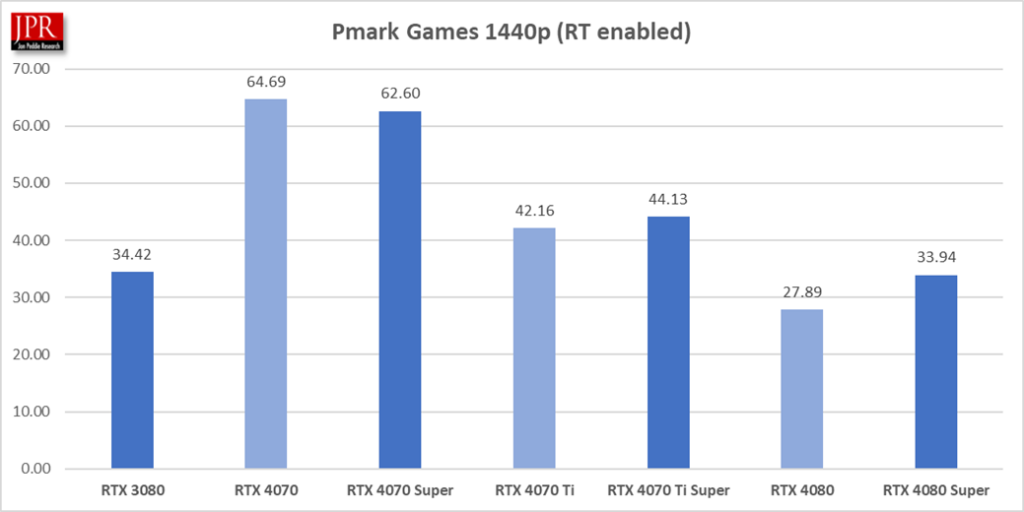
In games running at 1440p with ray tracing enabled, the RTX 4080 Super again proves to be a better value than the RTX 4080 by 20% due to its lower MSRP. This is the one test where an original RTX 4000-series card bests its Super counterpart. The slight advantage of the RTX 4070 over the RTX 4070 Super is due to the RTX 4070’s performance and lower wattage.
Where is the market going?
As of today, February 2, 2024, you can still get the RTX 4080 Super for $100 over MSRP, while on other sites such as Amazon, the cost for a new Super is already $250 over MSRP.
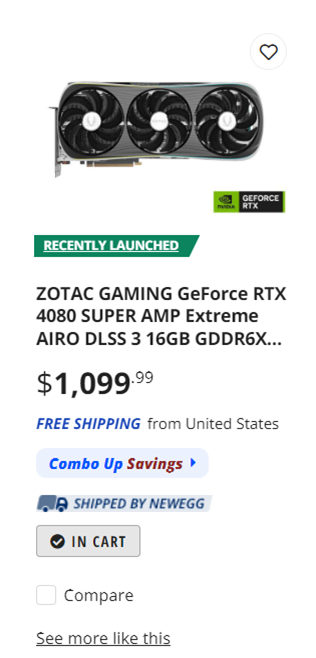
Over the fourth quarter of 2023, we saw high-end Nvidia add-in boards elevate in price. This could be a combination of demand during the holiday season and the lack of excess inventory.
Although we believe that prices will stabilize over Q1, there is no guarantee—for those in the market to upgrade to a Super-series card, the time should be sooner rather than later.